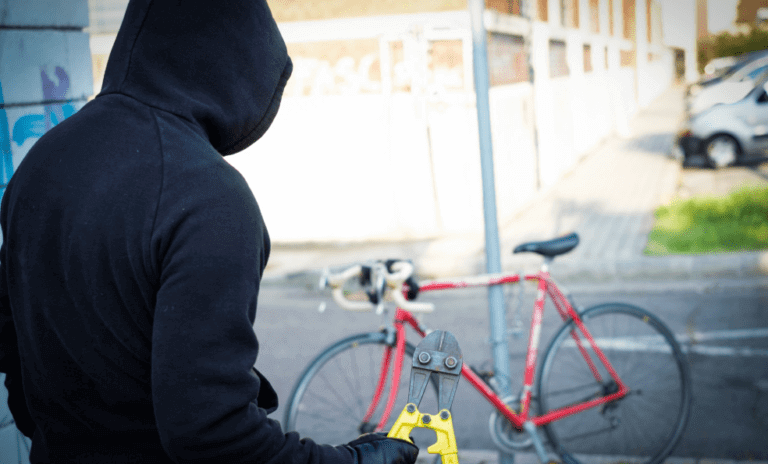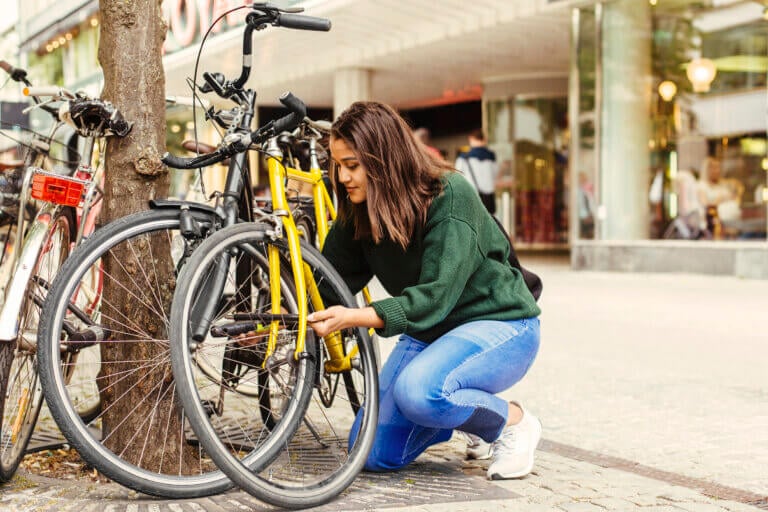Keep your saddle safe with these helpful security tips on how to lock a bicycle seat.

From electric bike batteries to bicycle saddles to front wheels, thieves are out to steal them all. Any part of your bike that isn’t secured properly is up for grabs — so here is some advice on how to lock a bicycle seat and lower your chances of falling victim to saddle theft.
The cost of stolen bike seat replacements
Even if you have bicycle insurance, replacing a stolen bike saddle is a pain because it’s another thing on your already long to-do list. And if you don’t have bicycle insurance, a stolen bike saddle replacement can be surprisingly expensive.
Certain brands like Fizik, Specialized, and Supacaz are known for their unparalleled comfort and support — which is why the price tags can be a little high (well worth it, but expensive nonetheless). Plus, custom bike saddles that conform to the fit of your body can take weeks or even months to properly break in. For these reasons, a replacement bike seat can cost you a couple of hundred bucks and set you back a few weeks.
Take your bike seat and seat post with you
If you don’t have extra locks or seat post security devices hanging around, you can pop your saddle and seat post off — and take them with you. This is a really simple solution, but it’s also not the most practical.
Even though you likely don’t need keys or tools for this, you’ll have to work around the logistics of lugging part of your bicycle around with you everywhere. In addition, without the seat post and saddle in place, your frame could fill up with debris or water if it rains. This could lead to rust or a longer maintenance routine.
Lock a bicycle seat with non-quick release bike seat clamps
A lot of bicycles already feature a quick-release seat clamp (also known as a QR clamp). This lets cyclists adjust seat heights in as little as a few seconds and makes trail rides a bit easier. But because quick-release clamps are, naturally, easy to release, this makes saddles a prime target for theft.
To up your security game, replace your quick-release bike seat clamp with non-quick release clamps. This makes it harder to adjust your seat height on the go because you’ll need to carry some tools around, but it also makes it harder for thieves to quickly snatch your saddle.
You can try an Allen key or nut-and-bolt seat clamp set. Allen key (or hex key) bike seat clamps are easier to find on the market, and it doesn’t take a ton of effort to install them on your bike. Nut-and-bolt clamps work just as well, but they’re usually found on less expensive bike models and children’s bicycles.
Try bicycle seat post star-nut bolts
These are pretty similar to Allen key non-quick release seat clamps because you’ll need a tool to release the saddle. But, they’re a little less common than traditional Allen keys or hex keys because of their six-point star shape.
You can still buy them from bike shops and hardware stores and they’re relatively inexpensive — but even fewer cyclists use them to lock a bicycle seat.
Increase bike security with proprietary locking seat clamps
Non-quick release seat clamps require tools to adjust the seat height or remove the saddle. But those tools can be purchased from pretty much any bike shop or hardware store. If you really want to prevent a saddle thief from hitting your bike, upgrade to a proprietary seat clamp locking system to lock a bicycle seat.
Some bike seat clamp manufacturers have developed locking systems specific to their models. This means you have to purchase their specific tool to remove or adjust the saddle — instead of a generic Allen key that is easy to buy. They might be more expensive, and if you lose the key you’re out of luck until you can buy another.
But in short, a proprietary locking bicycle seat clamp is much harder to crack compared to quick release and even non-quick release clamps. In addition, thieves who see a locking device they can’t break or easily crack might be more likely to move on to another target.

Secure your bike seat with a secondary lock
If you’re short on time or aren’t ready to invest in a complex seat locking system, you might be able to lock a bicycle seat with what you already have at home. Cable locks are pretty long and if you have some extra slack after feeding it through your frame, you can feed it through the rear of the saddle.
If your cable lock doesn’t have enough slack, you can use another bike lock you have laying around to secure the saddle to the frame. In theory, a bike thief could release your bike seat, but they wouldn’t be able to remove your bike seat.
However, multiple locks can be a pain to carry around — not to mention adding an extra step to your security routine each time you ride. Also, if you’re a competitive racer, the second lock will tack on some additional weight and might bump into your legs on a ride. But if you’re in a pinch, using more than one lock can slow a thief down or prevent theft altogether.
Anti-theft resources
Did you know that bike thieves will steal pretty much anything that’s not properly locked? Your bike seat, your e-bike battery, and even your locks might be at risk for theft. Use the resources below to learn more about bicycle theft and how to prevent it. Plus, get some helpful information on how you can protect yourself against theft for as little as $8 a month.
